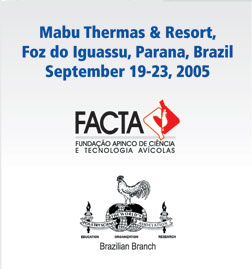Contributed Papers: Oral Presentations
Pathology |
Reasons for
Field Problems with Eimeria maxima:
E. acervulina versus E. maxima
Greg
F. Mathis, Southern Poultry Research, Inc.
The three most commonly
occurring species of Eimeria infecting chickens are
Eimeria acervulina, E. tenella, and E. maxima. Even
though E. maxima is very immunogenic, lesions are
often observed in the field late in a growout. A survey
of 50 coccidial field isolates showed that 36 were
predominately E. acervulina, 4 E. maxima, and 10 E.
tenella. All of the E. maxima isolates came from farms
where the broilers were over 28 days old. Most of
the E. acervulina isolates were from broilers that
were 18 to 28 days old. The daily oocyst shedding
pattern for a commercial coccidial vaccine was examined
in floorpen birds. Birds vaccinated for coccidiosis
at the hatchery were placed into pens on new pine
shavings. The shedding of E. acervulina type oocysts
peaked around 18 days. A small peak of E. maxima was
observed around 28 days. A battery cage study was
conducted to examine whether E. acervulina could be
interfering with E. maxima development. Birds were
challenged at 14 days of age with E. acervulina and/
or E. maxima. The oocyst per bird challenge levels
were none (Trt. 1), E. acervulina 100,000 (Trt. 2),
E. acervulina 100,000 plus E. maxima 5,000 (Trt. 3),
E. acervulina 50,000 plus E. maxima 5,000 (Trt. 4),
E. acervulina 25,000 plus E. maxima 5,000 (Trt. 5),
and E. maxima 5,000 (Trt. 6). Each treatment consisted
of 3 replications in a complete randomized block design.
E. maxima alone caused 21 % weight reduction and 2.75
lesion score. The 100,000 and 50,000 E. acervulina
oocyst level reduced E. maxima lesions to 1.33. The
25,000 E. acervulina oocyst level only slightly reduced
E. maxima lesions to 2.25. The E. maxima did not interfere
with any of the E. acervulina infections. This study
suggests that E. acervulina interferes with colonization
or development of E. maxima. As birds become more
immune to E. acervulina, then E. maxima has more of
an opportunity to develop.
